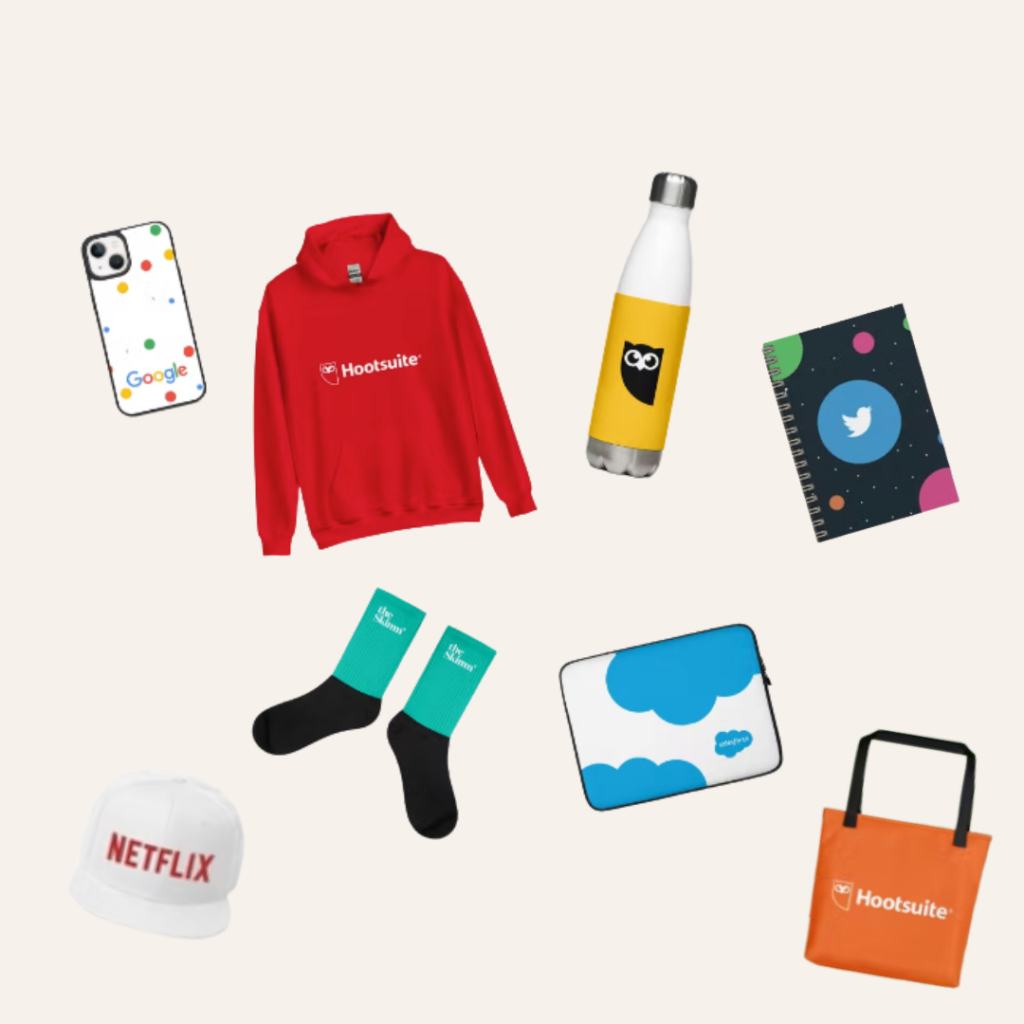Dealing with difficult employees who exhibit bad behavior can undermine the productivity and morale of the whole team. A difficult employee may have a bad attitude, be uncooperative, and be disengaged. It’s critical for leadership to address the root causes of the difficult coworker’s actions.
Specific examples of difficult employees include those who are consistently late, have conflicts with coworkers, resist feedback, or display low morale. There are several ways to deal with these situations, such as having a difficult conversation to provide feedback or involving human resources.

How SwagMagic can help your brand?
- Bulk Buy & Save on your gifts!
- Curate Customized Swag Boxes!
- Launch Your Store for your employees!
- Secure Swag Storage with us!
If the difficult employee’s behavior does not improve after attempts to handle the situation, letting them go may be necessary to avoid further disrupting the work environment. Though never easy, confronting toxic employees is key to maintaining team unity and engagement among coworkers.
The goal is to deal with a difficult employee in a way that addresses any underlying issues impacting their attitude and performance. Boosting morale, making them feel appreciated, and reinforcing positive behaviours can help diffuse negativity. Leadership can turn around even the most difficult situations with the right approach.

Challenges of Managing Difficult Employees
- Decreased Morale: One problematic employee can negatively impact the entire team’s morale.
- Lost Productivity: Time spent addressing these issues can detract from tasks and projects.
- Risk of Escalation: If not handled promptly, minor problems can become bigger, sometimes leading to legal consequences.
- Strained Manager-Employee Relationships: It can be challenging for managers to maintain a good relationship with a difficult employee, impacting overall team dynamics.
Reasons Behind Difficult Behavior of Coworkers
- Unaddressed Personal Issues: External factors, like personal life disturbances, can cause employees to act out at work. Problems like marital issues, financial stress, or health concerns can distract and decrease productivity or negative behaviours.
- Mismatch of Job Role: An employee might be in a role that doesn’t match their skills or interests. This can lead to frustration and a lack of motivation.
- Need for Training: Sometimes, an employee may not have received adequate training, causing them to struggle with their tasks.
- Clashing Personalities: Personality conflicts between coworkers or between an employee and their supervisor can lead to disputes and misunderstandings.

Effective Strategies to Deal With a Difficult Employee
Handling difficult employees tests management acumen, interpersonal skills, and patience. Influential leaders use strategies tailored to the situation and the individual. Here’s a deeper dive into some of these strategies:
- Open Communication:
- Initiate Dialogue: Approach the employee to discuss observed problematic behaviour. Often, starting a conversation with appreciation for their efforts can set a positive tone.
- Active Listening: Understand their viewpoint without interruption.
- Feedback Loops: Regular check-ins help gauge progress.
- Provide Clear Feedback:
- Specificity is Key: Address specific issues and always follow up with positive feedback for their support.
- Positive Reinforcement: Highlighting their achievements can motivate them. For significant achievements, consider corporate gifting as a token of appreciation.
- Future Orientation: Offer solutions and set a path for progress.
Appreciate Their Contributions:
- Regular Acknowledgment: Regularly thank them for their contributions and support. This fosters a positive work environment.
- Swag & Corporate Gifting: Personalized gifts or company merchandise can be a token of appreciation and boost morale.

- Implement Training Programs:
- Skill Development: Offer workshops, courses, or mentoring.
- Soft Skills Training: Focus on communication, teamwork, or conflict resolution.
- Feedback Mechanisms: Check the implementation of learned skills.
- Consider Mediation:
- Neutral Third Party: An objective mediator can help resolve conflicts.
- Conflict Resolution Training: Equip employees to address disputes.
- Group Sessions: Collaborative solutions can be found in group discussions.
- Set Clear Expectations:
- Documented Job Roles: Define job responsibilities.
- Performance Metrics: Offer clear performance targets.
- Regular Reviews: Track progress and adjust as needed.
- Document Everything:
- Record Keeping: Maintain detailed logs.
- Protection Against Legal Issues: Comprehensive records are invaluable.
- Consistency: Treat all employees uniformly.
- Re-evaluate Job Roles:
- Skill-to-Role Match: Ensure employees are in roles suited to their skills.
- Potential Transfers: Find roles where the employee might excel.
- Redesigning Roles: Adjust job roles for better performance.
- Seek External Advice:
- HR Consultation: Engage HR professionals for deeper insights.
- External Counselors: Counseling can address deeper behavioural issues.
- Continuous Learning: Stay updated with the latest HR strategies.
Comparative Insights on Dealing with Difficult Coworkers: Male vs Female
- Communication Approach: For female employees, it might be beneficial to approach situations with empathy and understanding, whereas, with male employees, directness might yield better results.
- Mentorship: While mentorship is universally beneficial, female employees might benefit more from female role models, given their unique challenges in specific industries.
- Training: While women might benefit from training programs that bolster assertiveness and leadership, men might benefit more from those that enhance emotional intelligence and team collaboration.
- Feedback: Constructive feedback is crucial for all. However, ensuring feedback is devoid of gender biases, especially with female employees, is critical. With male employees, clarity and directness can be more impactful.

Unique Way to Deal with Difficult Employees in Work Environment
Remember TechPinnacle?
TechPinnacle’s management, upon recommendation, decided to explore how SwagMagic might remedy their problem.
10 Transformative Solutions SwagMagic Offered to Handle a Difficult and Poor Behavior
- Customized Appreciation Kits: TechPinnacle sent out personalized ‘Thank You’ kits to employees who went the extra mile. Each kit contained merchandise tailored to the employee’s tastes.
- Monthly Swag Store Access: Employees were given access to a Swag Store to choose from a range of promotional merchandise. It added an element of choice and personalization.
- Branded Workspace Items: To add a personal touch to the workspace, employees received branded stationery, mousepads, and coffee mugs. A daily reminder of belongingness.
- Gift Cards for Milestones: Employees were rewarded with gift cards for work anniversaries or significant achievements. This flexible reward allowed them to select their desired item.
- Feedback Rewards System: Employees were encouraged to give feedback and received custom badges or pins in return. It bridged the gap between management and staff.
- Team Swag Packs: For teams that collaborated well on projects, SwagMagic curated team packs. These included matching shirts, caps, or even tech gadgets.

- Festive Gift Boxes: During festive seasons, employees received beautifully curated snack gift boxes. This added a touch of warmth and personal connection.
- Training Completion Kits: Employees were given custom kits after completing in-house training or skill development courses, boosting enthusiasm for further learning.
- New Joiner Welcome Packs: To integrate new employees seamlessly and make them feel valued, SwagMagic designed welcome packs. These packs were filled with essentials and fun items to kickstart their journey.
- Personal Milestone Acknowledgment: Whether it was a birthday, a new baby, or a wedding, SwagMagic helped TechPinnacle acknowledge personal milestones with thoughtful gifts.
The Transformation
As months went by, a significant shift was evident. The difficult employees felt more acknowledged, improving morale and reducing disruptions. Their productivity increased, and they became more receptive to feedback. The air at TechPinnacle was more positive and more vibrant.
Transforming Troubled Talent and Difficult Conversation: Handling a Difficult Employee
Dealing with disengaged or challenging employees exhibiting undesirable behaviors can be difficult. But you don’t have to handle these situations alone. Book a consultation with our HR experts, skilled in dealing with difficult employees. We’ll explore your unique situation, provide guidance on addressing root causes, and equip you with strategies to improve productivity. Don’t let a problematic employee continue undermining team morale or performance. Take action today.
Curate the perfect box of handpicked gift they’ll love and send joy their way
Effectively dealing with an undesirable employee situation requires addressing engagement and attitude issues. Managers can turn around disengaged employees with the right approach that addresses underlying needs while correcting unwanted behaviors. Though never easy, dealing constructively with struggling team members provides the best opportunity for positive change. Both the individual and the wider team stand to benefit. Now is the time to take tentative steps towards a more harmonious and productive work environment.
It’s fascinating how simple gestures can transform workplace dynamics. TechPinnacle’s collaboration with SwagMagic wasn’t just about gifts, recognition, value, and the human touch. Sometimes, all it takes is a bit of magic (or swag) to turn things around!
References:
- Lencioni, P. (2002). The Five Dysfunctions of a Team: A Leadership Fable. Jossey-Bass.
- Robbins, S.P., & Judge, T.A. (2017). Organizational Behavior. Pearson.
- Stone, D. (2000). Difficult Conversations: How to Discuss What Matters Most. Penguin Books.
- Tiedens, L. Z., & Fragale, A. R. (2003). Power moves: Complementarity in dominant and submissive nonverbal behavior. Journal of Personality and Social Psychology, 84(3), 558.

Leave a Comment